|
|
|
Sort Order |
|
|
|
Items / Page
|
|
|
|
|
|
|
| Srl | Item |
| 1 |
ID:
110432


|
|
|
|
|
| Publication |
2011.
|
| Summary/Abstract |
Cerrado, a savannah region, is Brazil's second largest ecosystem after the Amazon rainforest and is also threatened with imminent destruction. In the present study emergy synthesis was applied to assess the environmental performance of a coffee farm located in Coromandel, Minas Gerais, in the Brazilian Cerrado. The effects of land use on sustainability were evaluated by comparing the emergy indices along ten years in order to assess the energy flows driving the production process, and to determine the best production model combining productivity and environmental performance. The emergy indices are presented as a function of the annual crop. Results show that Santo Inácio farm should produce approximately 20 bags of green coffee per hectare to accomplish its best performance regarding both the production efficiency and the environment. The evaluation of coffee trade complements those obtained by contrasting productivity and environmental performance, and despite of the market prices variation, the optimum interval for Santo Inácio's farm is between 10 and 25 coffee bags/ha.
|
|
|
|
|
|
|
|
|
|
|
|
|
|
|
|
| 2 |
ID:
110436


|
|
|
|
|
| Publication |
2011.
|
| Summary/Abstract |
This article addresses the issue of wind energy acceptance in the Canadian province of Quebec and, in particular, the impact of different models of wind power development on the degree of social acceptance. We show that the dominant advocacy coalition, which favors a hard path energy development in general, enforces a large-scale development of wind energy. Two other coalitions - a soft path coalition and a nationalist coalition - oppose this development, but not wind energy per se. We argue that difference in belief systems explains their opposition rather than planning issues or NIMBY concerns. We also contend that, despite its predominance over (wind) energy policy, the hard path coalition is willing to learn and make concessions towards the soft path coalition, but not towards the nationalist coalition.
|
|
|
|
|
|
|
|
|
|
|
|
|
|
|
|
| 3 |
ID:
110363
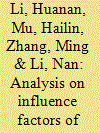

|
|
|
|
|
| Publication |
2011.
|
| Summary/Abstract |
With the intensification of global warming and continued growth in energy consumption, China is facing increasing pressure to cut its CO2 (carbon dioxide) emissions down. This paper discusses the driving forces influencing China's CO2 emissions based on Path-STIRPAT model-a method combining Path analysis with STIRPAT (stochastic impacts by regression on population, affluence and technology) model. The analysis shows that GDP per capita (A), industrial structure (IS), population (P), urbanization level (R) and technology level (T) are the main factors influencing China's CO2 emissions, which exert an influence interactively and collaboratively. The sequence of the size of factors' direct influence on China's CO2 emission is A>T>P>R>IS, while that of factors' total influence is A>R>P>T>IS. One percent increase in A, IS, P, R and T leads to 0.44, 1.58, 1.31, 1.12 and -1.09 percentage change in CO2 emission totally, where their direct contribution is 0.45, 0.07, 0.63, 0.08, 0.92, respectively. Improving T is the most important way for CO2 reduction in China.
|
|
|
|
|
|
|
|
|
|
|
|
|
|
|
|
| 4 |
ID:
110376
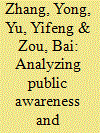

|
|
|
|
|
| Publication |
2011.
|
| Summary/Abstract |
The aim of this paper is to analyze consumers' awareness towards electric vehicle (EV) and examine the factors that are most likely to affect consumers' choice for EV in China. A comprehensive questionnaire survey has been conducted with 299 respondents from various driving schools in Nanjing. Three binary logistic regression models were used to determine the factors that contribute to consumers' acceptance of EVs, their purchase time and their purchase price. The results suggest that:
(1)
Whether a consumer chooses an EV is significantly influenced by the number of driver's licenses, number of vehicles, government policies and fuel price.
(2)
The timing of consumers' purchases of an EV is influenced by academic degree, annual income, number of vehicles, government policies, the opinion of peers and tax incentives.
(3)
The acceptance of purchase price of EVs is influenced by age, academic degree, number of family members, number of vehicles, the opinion of peers, maintenance cost and degree of safety.
These findings will help understand consumer's purchase behavior of EVs and have important policy implications related to the promotions of EVs in China.
|
|
|
|
|
|
|
|
|
|
|
|
|
|
|
|
| 5 |
ID:
110370


|
|
|
|
|
| Publication |
2011.
|
| Summary/Abstract |
We present evidence for the coexistence of two antagonistic sugarcane ethanol production technologies in Brazil, with the Southeast region of the country having relatively mechanized production processes, and the Northeast area using labor-intensive ones. We highlight the main differences between the hand-production and fully automated mechanical manufacturing in the Brazilian ethanol industry and examine the historical, political, and economic factors that induced this regional technology gap that is currently observed. We then construct an environmental model based on a 375-industry interregional input-output system for the Brazilian regions, in order to determine the extent to which the primitive ethanol production of Northern Brazil differs from the automated manufacture technologies of the South in terms of greenhouse gas emissions. We show that ethanol produced with modern technologies generates lower carbon dioxide (CO2) emissions than ethanol produced with traditional production processes. We also demonstrate that ethanol, regardless of the technology with which it was produced, is more carbon-efficient than petrochemical products.
|
|
|
|
|
|
|
|
|
|
|
|
|
|
|
|
| 6 |
ID:
110355
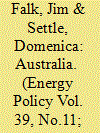

|
|
|
|
|
| Publication |
2011.
|
| Summary/Abstract |
This paper considers energy policy in Australia in the context of its considerable energy resources, climate change and a recent change in government. It examines the possible paths that future energy use and policy in Australia could take, including published projections based largely on a "business as usual" approach and projections based on a dramatic shift towards more efficient use of energy and renewable energy technologies. It also considers the various factors affecting future policy direction, including energy security, the advocacy in Australia for establishing nuclear electricity generation and other parts of the nuclear fuel-cycle, responses to climate change, and carbon sequestration. It concludes that while the Australian Government is currently reluctant to move away from a dependence on coal, and unlikely to adopt nuclear energy generation, a low-emissions future without waiting for the deployment of carbon capture and storage and without resorting to nuclear power is within reach. However, in the face of strong pressure from interest groups associated with energy intensive industry, making the necessary innovations will require further growth of community concern about climate change, and the development of greater understanding of the feasibility of employing low carbon-emissions options.
|
|
|
|
|
|
|
|
|
|
|
|
|
|
|
|
| 7 |
ID:
110365


|
|
|
|
|
| Publication |
2011.
|
| Summary/Abstract |
We discuss two main job creation statistics often used by solar advocates to support increased solar deployment. Whilst overall solar technologies have a tendency to be labor-intensive, we find that the jobs per gigawatt hour statistic is relatively mis-leading as it has a tendency to reward technologies that have a low capacity factor. Ultimately the lower the capacity factor the more amplified the solar job creation number.
|
|
|
|
|
|
|
|
|
|
|
|
|
|
|
|
| 8 |
ID:
110389
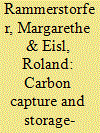

|
|
|
|
|
| Publication |
2011.
|
| Summary/Abstract |
The following article deals with real options modeling for investing into carbon capture and storage technologies. Herein, we derive two separate models. The first model incorporates a constant convenience yield and dividend for the investment project. In the second model, the convenience yield is allowed to follow a mean reverting process which seems to be more realistic, but also increases the model's complexity. Both frameworks are to be solved numerically. Therefore, we calibrate our model with respect to empirical data and provide insights into the models' sensitivity toward the chosen parameter values. We found that given the recently observable prices for carbon dioxide, an investment into C O2-storage facilities is not profitable.
|
|
|
|
|
|
|
|
|
|
|
|
|
|
|
|
| 9 |
ID:
110430


|
|
|
|
|
| Publication |
2011.
|
| Summary/Abstract |
This study examines the annual CO2 emissions embodied in China's exports from 2002 to 2008 using environmental input-output analysis. Four driving forces, including emission intensity, economic production structure, export composition, and total export volume, are compared for their contributions to the increase of embodied CO2 emissions using a structural decomposition analysis (SDA) technique. Although offset by the decrease in emission intensity, the increase of embodied CO2 emissions was driven by changes of the other three factors. In particular, the change of the export composition was the largest driver, primarily due to the increasing fraction of metal products in China's total export. Relevant policy implications and future research directions are discussed at the end of the paper.
|
|
|
|
|
|
|
|
|
|
|
|
|
|
|
|
| 10 |
ID:
110434


|
|
|
|
|
| Publication |
2011.
|
| Summary/Abstract |
Facing global climate change and scarce petroleum supplies, the world must switch to sustainable energy systems. While historical transitions between major energy sources have occurred, most of these shifts lasted over a century or longer and were stimulated by resource scarcity, high labor costs, and technological innovations. The energy transition of the 21st century will need to be more rapid. Unfortunately, little is known about how to accelerate energy transitions. This article reviews past transitions and factors behind them, along with their time frames. Three modern case studies are discussed: Brazil, which shifted from an oil-based transportation system to one based on sugarcane-ethanol (success); France, which shifted from oil-fired electric power to nuclear power (success); and the United States, which attempted to shift from foreign oil to a mix of domestic energy resources (failure). Lessons from these attempts to govern energy transitions are discussed. Several policy instruments to accelerate a transition are identified, though even under ideal circumstances a global energy supply transition will be very slow. Given the need to simultaneously implement programs in countries with different political economies, a greater focus on energy efficiency, promotion of Smart Grids, and possibly a new treaty should yield more timely results.
|
|
|
|
|
|
|
|
|
|
|
|
|
|
|
|
| 11 |
ID:
110439


|
|
|
|
|
| Publication |
2011.
|
| Summary/Abstract |
Zecca and Chiari (2010) have sought to challenge the findings of Nel and Cooper (2009), who argued that the impending peak and decline of fossil fuel production will most likely lead to a lower emissions trajectory than the majority of scenarios offered by the IPCC. Zecca and Chiari used their own model to produce a higher projection of atmospheric CO2 concentration, drawing on the conclusions of Archer (2005) to do so.
In this short comment, we show that the model of Zecca and Chiari is an erroneous interpretation of Archer (2005). We present a model based on an improved interpretation of Archer's paper and demonstrate that the model still significantly overpredicts atmospheric CO2 with respect to historical observations of CO2 concentrations.
Furthermore, whichever carbon cycle model one chooses to use (i.e. to convert a carbon emissions scenario into an atmospheric CO2 concentration), the primary concerns raised by Nel and Cooper (2009) - regarding an inability to achieve the IPCC's high emissions scenarios due to fossil fuel constraints - remain valid. These concerns are supported by a growing body of literature pointing to a peak in world oil and coal production within the coming few decades.
|
|
|
|
|
|
|
|
|
|
|
|
|
|
|
|
| 12 |
ID:
110366


|
|
|
|
|
| Publication |
2011.
|
| Summary/Abstract |
As a nation develops its nuclear strategies, it must consider various aspects of nuclear energy such as sustainability, environmental-friendliness, proliferation-resistance, economics, technologies, and so on. A nuclear fuel cycle study could give convincing answers to many questions in regard to technical aspects. However, one nuclear fuel cycle option cannot be superior in all aspects. Therefore a nation must identify its top priority and accordingly evaluate all the possible nuclear fuel cycle options. For such a purpose, this paper examined four different fuel cycle options that are likely to be plausible under situation of Republic of Korea: once-through cycle, DUPIC recycling, thermal recycling using MOX fuel in PWR (pressurized water reactor), and SFR (sodium cooled fast reactor) employing fuel recycling by a pyroprocess. The options have been quantitatively compared in terms of resource utilization and waste generation based on 1 TWh electricity production at a "steady-state" condition as a basic analysis. This investigation covered from the front-end of the fuel cycles to the final disposal and showed that the Pyro-SFR recycling appears to be the most competitive from these material quantitative aspects due to the reduction of the required uranium resources and the least amount of waste generation.
|
|
|
|
|
|
|
|
|
|
|
|
|
|
|
|
| 13 |
ID:
110423


|
|
|
|
|
| Publication |
2011.
|
| Summary/Abstract |
Assessment of urban energy use may proceed by a number of methods. Here we derive an energy account from local statistics, and compare them with an input output (IO) analysis as applied to Melbourne, Australia. These approaches highlight different aspects of urban energy use and comparable outputs are presented together to assess consistency, to identify complementarities and discuss the insight each approach brings to understanding urban energy. The IO method captures the direct and embodied primary energy requirements of local household expenditure (235.8 GJ/capita/year) while the regional assessment more directly accounts for local production activity (258.1 GJ/capita/year). The parity of these results is unexpected for a developed city with a strong tertiary sector. Sectoral detail reveals differences between the primary energy required by Melbourne's economic structure and that ultimately required through the full supply chain relating to household expenditure. This is accompanied by an IO analysis of the geography of Melbourne's 'energy catchment'. It is suggested that the IO consumption and regional production approaches have particular relevance to policies aimed at consumption behaviour and economic (re)structuring, respectively. Their complementarity further suggests that a combined analysis would be valuable in understanding urban energy futures and economic transitions elsewhere.
|
|
|
|
|
|
|
|
|
|
|
|
|
|
|
|
| 14 |
ID:
110437


|
|
|
|
|
| Publication |
2011.
|
| Summary/Abstract |
This article challenges the notion that energy efficiency and 'clean' energy technologies can deliver sufficient degrees of climate change mitigation. By six arguments not widely recognized in the climate policy arena, we argue that unrealistic technology optimism exists in current climate change mitigation assessments, and, consequently, world energy and climate policy. The overarching theme of the arguments is that incomplete knowledge of indirect effects, and neglect of interactions between parts of physical and social sub-systems, systematically leads to overly optimistic assessments. Society must likely seek deeper changes in social and economic structures to preserve the climatic conditions to which the human civilization is adapted. We call for priority to be given to research evaluating aspects of mitigation in a broad, system-wide perspective.
|
|
|
|
|
|
|
|
|
|
|
|
|
|
|
|
| 15 |
ID:
110368


|
|
|
|
|
| Publication |
2011.
|
| Summary/Abstract |
The introduction of flex-fuel vehicles since 2003 has made possible for Brazilian drivers to choose between high ethanol blends or gasoline depending on relative prices and fuel economies. In Sweden, flex-fuel fleets were introduced in 2005. Prices and demand data were examined for both Brazil and Sweden. Bioethanol has been generally the most cost-efficient fuel in Brazil, but not for all states. In any case, consumers in Brazil have opted for ethanol even when this was not the optimal economic choice. In Sweden, a different behavior was observed when falling gasoline prices made E85 uneconomical in late 2008. In a context of international biofuels expansion, the example of E85 in Sweden indicates that new markets could experience different consumer behavior than Brazil: demand falls rapidly with reduced price differences between ethanol and gasoline. At the same time, rising ethanol demand and lack of an international market with multiple biofuel producers could lead to higher domestic prices in Brazil. Once the limit curve is crossed, the consumer might react by shifting back to the usage of gasoline.
|
|
|
|
|
|
|
|
|
|
|
|
|
|
|
|
| 16 |
ID:
110435
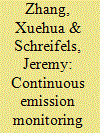

|
|
|
|
|
| Publication |
2011.
|
| Summary/Abstract |
The Chinese Government recently mandated the installation of continuous emission monitoring systems (CEMS) at state-controlled key polluting facilities in order to provide direct, real-time, continuous measurements of sulfur dioxide (SO2) emissions. By 2010, most coal-fired power plants in China have installed and are operating SO2 CEMS. As China's Central Government strengthens the SO2 control program and implements new nitrogen oxides (NOX) and carbon dioxide (CO2) control programs, the quality of and confidence in CEMS data will become more important. This study utilizes field surveys and existing literature on Chinese CEMS to analyze their operation and management. Our study found that the Chinese government has issued a set of regulations and technical guidance documents to standardize CEMS operation, management, and supervision, and to improve the quality of CEMS data. Many power plants have followed key parts of the national CEMS rules and guidance and are periodically inspected by local environmental authorities. This study suggests several options for addressing some of the gaps and problems with the CEMS operation and supervision and thus enhancing China's CEMS program.
|
|
|
|
|
|
|
|
|
|
|
|
|
|
|
|
| 17 |
ID:
110362


|
|
|
|
|
| Publication |
2011.
|
| Summary/Abstract |
The issue of subsidies on domestic energy prices has moved up the policy agenda, most recently as a result of the G20 commitment in September 2009 to phase out such subsidies. However, what constitutes a "subsidy" is complex and controversial. The IEA in its last World Energy Outlook claimed that Saudi Arabia was second in the world in terms of its levels of subsidy on domestic energy prices. However, because Saudi Arabia is a price maker in the international oil market, the methodology used by the IEA is seriously flawed. This paper explains the problems with the methodology for computing subsidies and explains the correct method in the case of Saudi Arabia. It then attempts to measure the levels of subsidy in Saudi Arabia using this methodology. However, while it converts the IEA's "subsidy" of $23 billion into a net "profit" of $5.7 billion, it goes on to point out that the current low price regime is causing problems for Saudi Arabia.
|
|
|
|
|
|
|
|
|
|
|
|
|
|
|
|
| 18 |
ID:
110402


|
|
|
|
|
| Publication |
2011.
|
| Summary/Abstract |
To investigate how fuel economy is valued in the Indian car market, we compute the cost to Indian consumers of purchasing a more fuel-efficient vehicle and compare it to the benefit of lower fuel costs over the life of the vehicle. We estimate hedonic price functions for four market segments (petrol hatchbacks, diesel hatchbacks, petrol sedans, and diesel sedans) to compute 95% confidence intervals for the marginal cost to the consumer for an increase in fuel economy. We find that the associated present value of fuel savings falls within the 95% confidence interval for most specifications, in all market segments, for the years 2002 through 2006. Thus, we fail to consistently reject the hypothesis that consumers appropriately value fuel economy.
|
|
|
|
|
|
|
|
|
|
|
|
|
|
|
|
| 19 |
ID:
110353


|
|
|
|
|
| Publication |
2011.
|
| Summary/Abstract |
The goal of international negotiations with the Democratic People's Republic of Korea (DPRK), when they begin again, will be to convince the DPRK to give up its nuclear weapons and the capabilities to produce them. The DPRK's energy sector is a key to resolution of the issue. Thus offering a well-considered, well-structured package of energy sector assistance options will be key to the sustainable success of the negotiations. This article briefly reviews some of the key options for DPRK energy assistance ranging from human capacity-building in fields like energy efficiency, renewable energy, and energy markets, to assistance with rebuilding key electricity and coal mining infrastructure, to integrated pilot energy/electricity grid/economic development projects on the county level, to light-water nuclear reactors. It then reviews preferences for DPRK assistance options as offered by North Koreans, and a summary of the likely points of view of the key DPRK actors that will be involved in negotiations.
|
|
|
|
|
|
|
|
|
|
|
|
|
|
|
|
| 20 |
ID:
110375


|
|
|
|
|
| Publication |
2011.
|
| Summary/Abstract |
This paper studies patenting dynamics in efficiency improving electricity generation technologies as an important indicator of innovation activity. We build a novel database of worldwide patent applications in efficiency-improving fossil fuel technologies for electricity generation and then analyse patenting trends over time and across countries. We find that patenting has mostly been stable over time, with a recent decreasing trend. OECD countries represent the top innovators and the top markets for technology. Some non-OECD countries, and particularly China, are also very active in terms of patenting activity in this sector. The majority of patents are first filed in OECD countries and only then in BRIC and other non-OECD countries. BRIC and other non-OECD countries apply for patents that are mostly marketed domestically, but BRIC countries represent important markets for patent duplication of OECD inventions. These results are indicative of significant technology transfer in the field of efficiency-improving technologies for electricity production.
|
|
|
|
|
|
|
|
|
|
|
|
|
|
|
|
|
|
|
|
|